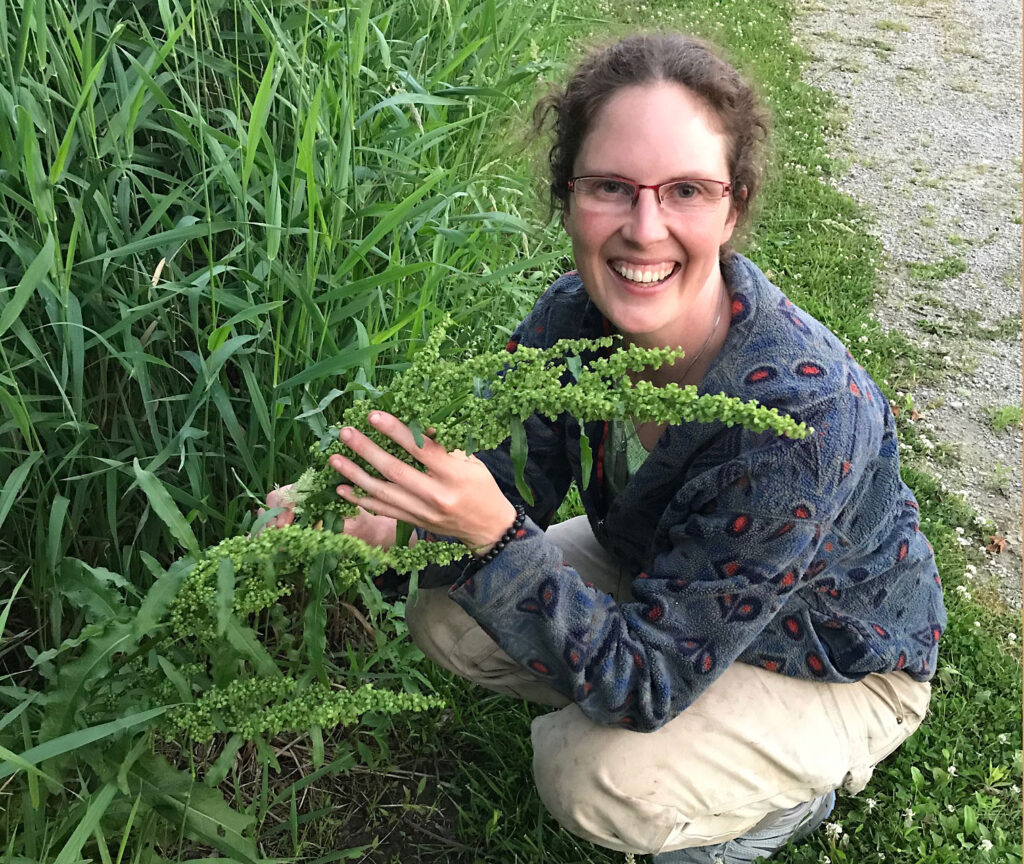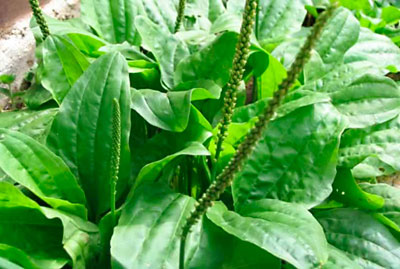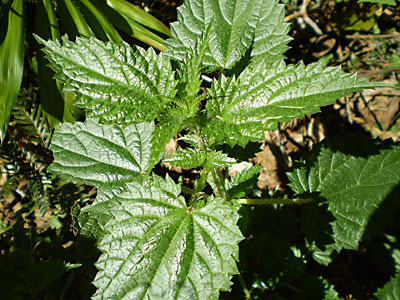
My mother’s favorite flowerbed at her east gate, the cornerstone of her garden really, is populated every summer by our favorite technicolor blooms: Neon orange snapdragons, hot pink zinnias, nearly glow-in-the-dark creeping Jennie, and the fluorescent blue spikes of perennial salvia. We sit on the porch at dusk admiring the twilight fiesta that looks like someone lit a Kaffe Fassett textile with a black light bulb. We take very little credit for any of it.
But come last March’s thaw, the bed was the stuff of my nightmares. Creeping Charlie (aka ground ivy, aka alehoof, aka Gill-over-the-ground, aka Glechoma hederac) had reached under the fence, right through the snow, and had set up shop in the soil, filling forty square feet of prized real estate with its scallop-leafed tentacles.
I spent hours swearing and tearing up the bed to remove every wispy vine and piece of root fragment I could find. I got most of it, but ol’ Charlie had already woven himself into the base of a 16-year-old meadow sage. Yeah, Chuck will show up again later this season. He’s now a permanent fixture of the front lawn and is currently sprinting up the base of the dogwood. “Creeping,” my eye. His eighth nickname, “run-away-robin,” is more accurate.
Homeowners across 46 states have done battle with this relative of the mint family, brought over on purpose, I found out—how insulting!—from Europe. All because it was nutrient rich, easily stored, and grew quickly. You mean someone wanted this plant?
Huh. Got me thinking. Common weeds, real groaners like creeping Charlie and fluffy dandelion that typically earn themselves the stink eye, might better be put to use than in my bucket of (ob)noxious weeds. Or … left right there in the soil? Shutter, ghasp, wheeze!
Listen. I spend my days editing out the wrong words and my evenings editing out the wrong plants—species that just don’t belong in my very crisp, manicured, and organized version of beauty. Shifting my proofreader’s mindset in the garden was going to take some doing. I’d need some help. And maybe a little therapy.
Here in Jefferson County you can’t throw a rock without hitting a green-thumbed goddess, so I got the attention of a qualified weed eater and lured her in with a trail walk invitation. With 20 years under her belt teaching regenerative holistic living, focused on tending the land and growing food as medicine, I wanted to know what Dhyana Miller was putting in her salad. (She doesn’t look nearly old enough to have that kind of experience, so whatever she’s eating, it’s seriously working for her.) The wildflowers and weeds along the trail and around the pond at Whitham Woods were a great entry point for my 45-minute crash course in Putting Stuff in my Mouth That Doesn’t Resemble Food.
Chew ’n’ Spit Medicine

The first thing I learned from Dhyana as we came upon some delicate white blooms growing through the trail fence was just one of “a thousand uses” of the yarrow plant. You don’t need a mortar and pestle to handle wounds or bee stings on the trail. Your own teeth and saliva do very nicely making a potent poultice from the fine, ferny leaves of the Achillea millefolium.
The totally munchable Plantago major, the broadleaf plantain, can also be used in this fashion, drawing out inflammation, venom, or insect parts that don’t belong in your arm. “I was in Oregon leading a trail crew for teens,” said Dhyana, “and one of the 15-year-old guys got a stinger, a hornet probably. I said, ‘Take this, chew it up, and put it on your spot,’ and it was quick! Within five to ten minutes that stinger had pulled out, dislodged with the poultice.” Dhyana suggested holding the poultice on by covering it with a whole (unchewed) plantain leaf tied on with wildgrass, in a pinch. Ahh, the plantain: edible, medicinal, and highly fashionable. Plus it comes in “wide” and “skinny” sizes for all body types.

The narrowleaf plantain, or Plantago lanceolata, which can thrive in even the most abused soils, has earned a nickname as “white man’s footprint,” Dhyana told me. In places where settlers traveled through, their wagon trains “no doubt leaving a compacted trail, these would sprout up in their wake.” This stuff is tough.
“I’ve got one bed that I’m working to change over from hardpan clay,” says Dhyana. “There’s plantain there and … they’re doing a job. They’ll show up in an area because they are needed there. They are serving a role in the grand web of ecology.”
Moontime Medleys & More
Where the trail curves south through a hilly meadow, a patch of red clover was blooming in a swath of purple. “I love to harvest red clover a field like this, when they’re really ripe and pink and luscious looking. And you can eat the raw flowers.” Not only are the nectar and tubular petals gently sweet, they have some pretty sweet health benefits. The Trifolium pretense contains biochanin A, which has been shown to inhibit the activation of cancer.
“I don’t know if you’ve ever put them in a tea for ‘moontime’—your menstrual cycle?” Dhyana queried. I shook my head. “Really helpful,” she explained. “Red clover and red raspberry leaf are wonderful healing allies for helping to balance the hormones. They go well together, also with nettle.”
Other than a painful encounter with one as a kid, my only reference for stinging nettle was indeed its beneficial use as a tea: My boss is prone to sneezing fits when she consumes cheese, but a cup of nettle tea stops the hachoo-ing like magic.

“Stinging nettles are one of my faaavorite plants,” Dyana said affectionately. “They are full of minerals,” and have beneficial properties other than just squelching a sneeze. People who don’t mind a little sting might try applying nettle locally for arthritis pain. “The nettles are like little hyperdermic needles,” Dhyana explained as I tried not to wince, “releasing formic acid if they break the surface of the skin, reducing inflammation. If the needles break by drying or cooking or crushing, then they’re no longer active and stingy.”
After you’ve harvested the leaves of the Urtica dioica (gloves recommended), dry some for tea, or even try some in your food. “I just made some Borscht the other day,” she told me, “with golden and red beets, bay leaf, spices, salt, and nettle. It was so tasty, and I know I’m getting good nutrients in these times when the nutrient density of our soils is dropping overall.”
As with most plants, stinging nettles have look-alikes, Dhyana warned me, so do some reading and talk to your garden goddess friends before harvesting. Some telltale signs you’ve landed on the right plant are a squared stem (if you are bold enough to roll it between your fingers), an opposite leaf pattern, and deeply toothed leaves.
Mixed Greens

Even though this squatty succulent’s pregnant, puffy leaves are rather on the cute side, I call purslane “parking lot weed” because once I found a singular plant rooted in a tiny crack in the hottest, driest pavement around—and it still managed to dwarf a small car. While you won’t want to harvest the stuff from a parking lot, when taken from greener places less exposed to exhaust fumes, “purslane can be a real treat to throw in a salad,” said Dhyana. “Rinse off any dirt—leaving a little for your microbiome, for your gut—break them into little bits, and toss them into the mix. Really good. Lemony. Crunchy. Has some heartiness too, for a leaf.” My mouth was starting to water. Maybe because it was dinnertime.
“I’m actually transporting them into my garden,” she told me. “I just read purslane is the plant form containing the highest level of omega-3s.” Add to that antioxidant and antibiotic qualities—the list is so long you might want to keep some in the freezer. Cultivars of the Portulaca oleracea are used in cuisines around the world for salads, soups, stews, sauces, and as a thickening agent—and the seeds are edible too.
The fluffy-flowered dandelion doesn’t seem so dandy when it finds its way into my prized perennials, cozying into the roots where it’s guaranteed not to be messed with much. That crafty little son of a Taraxacum.
Most folks know by now they can—and probably should—be eating dandelions. The greens can be found not only at your whole foods grocer but in every garden, yard, vacant lot, park, prairie, ditch, and dale on every continent but Antarctica.
Every part of this plant, even the root, is loaded with vitamins, minerals, and fiber, and your liver, skin, and digestive tract will thank you for including this weed in your diet.
But how many of us are snacking on the blooms? Dhyana was excited to share a recipe for a frittered flowery snack. “Take the fresh blossoms cut long enough to have a handle stem, dunk the flower head face down into batter—pancake batter, or even something gluten free, or buckwheat—and fry them in some oil or ghee. They’re a delicious little treat and great with kids.” And if you have extra, make yourself a dandelion crown from a chain of stalks and blooms. Cuz everyone deserves be queen for a day.
The delicate curlycue tendril is one of the confirming features of a wild grape, or Vitis riparia. The forking tendrils make a tart, fresh snack packed with vitamin C, while the grapevine’s youngest translucent, shimmery leaves are more tender and mild. “If you’re keto, if you’re paleo, try making wraps from grape leaves,” suggested Dhyana. I began thinking about the lemony rice-stuffed grape leaves I love so dearly: dolma—the culinary legacy of the Ottoman Empire. “And grape is such a generous plant, you can cut the vine if you are in need of water. It’s an amazing vitality sap.”
I had finally discovered Dhyana’s secret elixir for eternal youth and would begin harvesting it immediately. Oh wild grape, you are generous.
Harvesting Help
“When I’m weeding my garden, I’m usually harvesting at the same time,” Dhyana says, but strongly cautions harvesting in haste. “I like to use as many of my senses as is safe to do so when getting to know a plant.” She recommends these rules of thumb for harvesting:
- Before consuming, consult a trusted friend who can identify the plant without doubt, and then refer to more than one wild edible ID guide to have certainty.
- Harvest from a large enough group that you don’t deplete the crop. Harvesting 1 out of every 10 plants is a responsible ratio.
- Harvest at least 20 feet from the road and nowhere near chemical “spray zones.”
Dhyana highly recommends getting your hands on a copy of Nature’s Garden by Samuel Thayer, a very helpful harvesting identification guide, as well as Katrina Blair’s gorgeous books The Wild Wisdom of Weeds: 13 Essential Plants for Human Survival and Local Wild Life: Turtle Lake Refuge Recipes for Living Deep.
From Foe to Friend
Thanks to Dhyana, I’m turning the page on a stale old story called My War on Weeds. Her appetite for learning—and teaching—about wild edibles and medicinal herbs was so bottomless, I walked away from our walk-and-talk with a whole lot more than a few fun facts and a mouthful of grape leaves.
As I tackled the following weeks’ projects in the garden, I started recognizing multitudes of the wild herbs and edibles Dhyana had showed me. “Well look at you, wild grape! … Hello there, little yarrow!” I am absolutely loving making friends with these new-to-me plants. And redefining what I call beautiful.
The 2nd series of Dhyana Miller’s Resilience Gardening course will take place Mondays via Zoom beginning in July 2020, exact dates TBA. Call her at (413) 367-6191 for information or to enroll.
